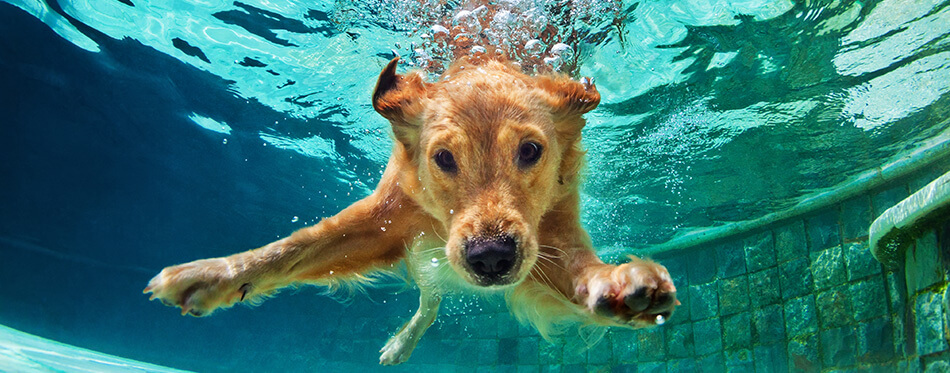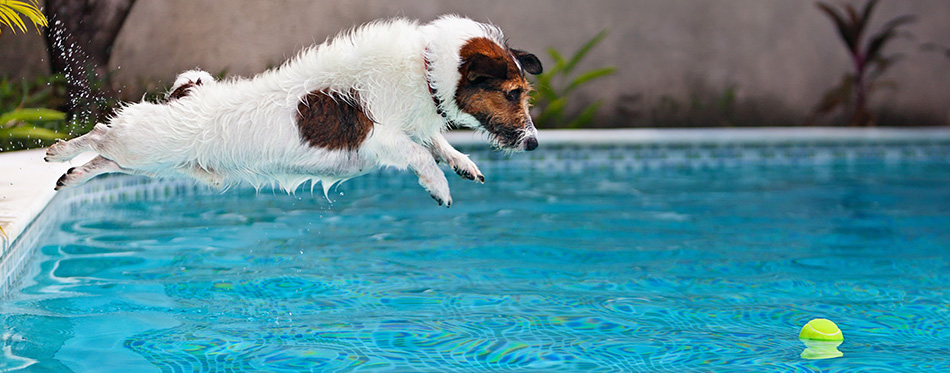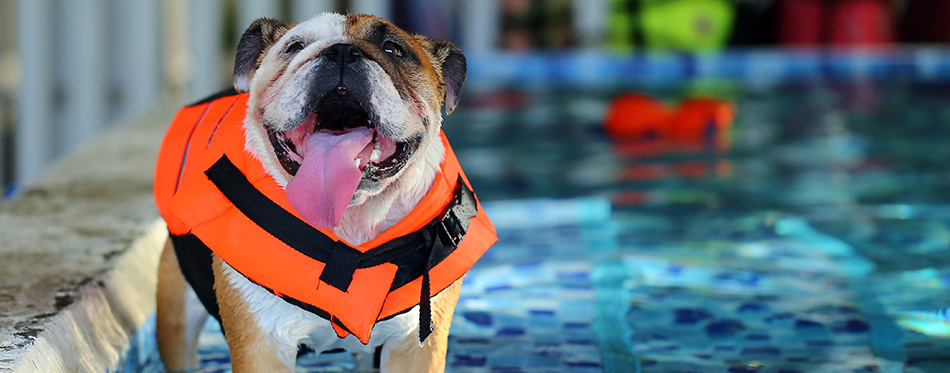Many dog breeds are not natural swimmers and can have a hard time trying to stay afloat. Some breeds are dense and muscular with a limited range of motion, some breeds are bred in such a way that swimming can be high risk due to genetic abnormalities making the task especially difficult, whereas other may simply struggle due to an especially thick or long fur coat. However, it is possible to teach dogs to swim, even if it’s just the basics for their own safety. The task can also be made much easier with repeated use of verbal and physical praise to encourage them to keep going.

The Benefits of Teaching Your Dog to Swim
There is a good range of benefits that your dog can get from learning to swim. The earlier you start, the more they will benefit from their new skill.
Full Body Fitness
A dog that learns to swim can get a much more intensive full-body workout from swimming. Ten minutes of swimming is a great exercise that is equal to nearly an hour of walking. So you can keep their exercise sessions short and sweet by taking them swimming instead of walking.
Building Confidence
Many dogs that learn to swim from a young age can develop a lot more confidence, whilst learning about limitations and understanding their own body better. It’s especially worthwhile if you have a backyard pool, as you can feel safe in the knowledge that they can swim to the edge.
Bonding
Learning to swim requires a lot of trust in the person helping you. You will need to keep your dog safe in the early stages and teach your dog to trust that you will protect them. Therefore, whenever you take your dog swimming it can help to strengthen your bond.
Low Impact
Swimming is much less impactful on their legs, which is why aquatic physiotherapy is often used for dogs with bad legs. As a long-term form of exercise, it can help to reduce stress on their joints, which is especially helpful for dogs that are predisposed to joint problems.
Energy Burning
For dogs that are naturally more energetic, swimming can be a great way to burn off some of that excess energy. Hyperactive puppies, in particular, tend to benefit from swim time, as well as giving their new owners some downtime whilst the puppy sleeps it off.
It’s Fun!
Teaching your dog how to swim isn’t just exercise, training, and skill-building, it’s also great fun!
Do All Dogs Know How To Swim?
Many people thinking of helping their dog learn to swim often ask the question “can all dogs swim?” This is understandable, as any good owner will want to know whether or not their dog is up to the task before pursuing swimming lessons. It is worth noting, first of all, that not all dogs know how to swim naturally. In fact, there are several breeds that are not natural swimmers, as previously mentioned, and so extra work may be needed to help them pick up this new ability. Breeds such as:
- Pug
- Shih Tzu
- Welsh Corgi
- Daschunds
- Basset Hound
- Chow Chow
- Staffordshire Bull Terriers
- Boxer
- French Bulldog
Before looking to start swimming sessions you should double-check whether or not your dog is likely to be naturally receptive to the lessons, or whether they might need some extra help, to begin with.

Why is Positive Reinforcement So Important?
Positive reinforcement has long been believed to be the best form of training for any dog. Dogs love to be rewarded for their efforts (who doesn’t?), so fusses and a positive tone of voice are effective ways to encourage them to keep going, as opposed to punishing their failures. Positive reinforcement helps to improve communication between you and your dog, so long as you are consistent in your responses.
It can also help to strengthen your bond with your dog as your dog understands what it is you need from them more and more with each lesson, as well as being the perfect way to get the family involved in their training as it can be done by anyone. If nothing else, it’s much more fun. Nobody wants to be stood around shouting angrily all the time, it’s far more enjoyable for all involved to be smiling and happy.
How to Teach a Dog To Swim
The most difficult part is right at the start. Some dogs may have an aversion to water, be it due to past trauma or just a general dislike of getting wet paws, which you will need to get them over before you can even think of starting swimming. But before you even reach that stage, you need to think about equipment.
Get a Doggie Life Vest
Doggie life vest: A doggie life vest can be a literal life saver, so make sure this flotation device is the first thing you purchase. You can find dog life jackets with a reflective trim which is ideal for owners looking to train their dog in natural bodies of water such as a dog-friendly lake. Though it is best to stick to swimming pool lessons, to begin with until your dog is confident. Additionally, make sure you look for a life vest with a handle so that you can help your pup to control its movements.
A doggie life jacket should fit their body snuggly and comfortably, without being restrictive. It should also support your dog’s belly to help them maintain balance. You can also purchase floatation devices that sit under your dog’s chin to help them keep their head above the water.
When making the transition from shallow water to deep water you will need to keep them in the vest. They may be perfectly content in the shallower water, and therefore ready for the next stage. However, deeper water has its own set of challenges and can be unnerving for pups the first time they enter it, so keeping the dog life jacket on them as they make this change is vital to ensuring their safety.
The First Lessons
1. Put the live vest on your pup, and put on your own life vest for extra security, then try to get them to enter the water of their own accord. Working from a kiddie pool with a gradual slope at the shallow end can be the perfect place to start. A good way to encourage them is to enter the water yourself and try and get them to come to you or present them with a toy to entice them in. The first swim lesson is usually quite tricky as it can be difficult to even get your dog to put its front legs into the water. Just give your dog plenty of gentle encouragement, and be patient. Dogs with especially short legs may find the water more intimidating than other dogs. So pay close attention to your dog’s body language and offer plenty of verbal praise when they move in the right direction. If your dog is a natural swimmer, then this step may only take a few minutes.
2. Once your dog is in the water with both its front and rear legs, you can start to walk slowly in the shallow section of the pool to get your dog used to the feel of water moving around its legs. Older dogs can be more set in their ways and may try to leave the pool, however, it is important to try and keep them in the shallow area for a little while. Though don’t force it. If they appear genuinely upset by the water then let them leave and start again from the beginning. All the while encouraging them with plenty of verbal praise and positive interaction.
3. If your pup adjusts easily to the water, then you can start paddling. Walk them into slightly deeper water where your dog’s feet just leave the ground. You may find that they become unsettled by this, but often they will begin paddling on their own. Keep a good grip on their life jacket whilst in the pool so that they feel secure and let them paddling around for a little while. Make sure they know they are doing a good job.
4. Once they seem to have gained some confidence in the water, and have relaxed you can start to look at exiting the pool. Sometimes it’s best to quit whilst you’re ahead, and if your dog seems happy, you shouldn’t push them to a point where anxiety could set in. So start showing them towards the exit of the pool. Point them in the right direction and give them a chance to guide themselves out of the water. You want to ensure they know how to exit the water if they need to.
5. Keep it up! Once your first lesson is done, that should hopefully be the hardest part over and done with. Make sure that your pooch gets lots and lots of praise and reward for its bravery and effort. And with each subsequent lesson, keep up that level of enthusiasm. Teaching your dog to swim does require patience and perseverance, but it can be incredibly rewarding and beneficial to your pup when all is said and done.

How To Teach a Puppy To Swim
The main difference between teaching an older dog and a puppy how to swim is the fact that puppies don’t need as much time in the water, and can become worn out more easily and need extra support, as their bodies are still strengthening and growing. So try to keep the lessons short, and only have them swim a short distance with each pass so as to give your pup adequate rest between paddles.
You want your puppy to have positive associations with their swim lessons. But if you overwork them it will be hard to counteract their stress or anxiety, even if you are providing treats and fusses. Additionally, if your pup hasn’t yet grown its second layer of fur then you will need to ensure the water temperature isn’t too low, just until their coat thickens.

